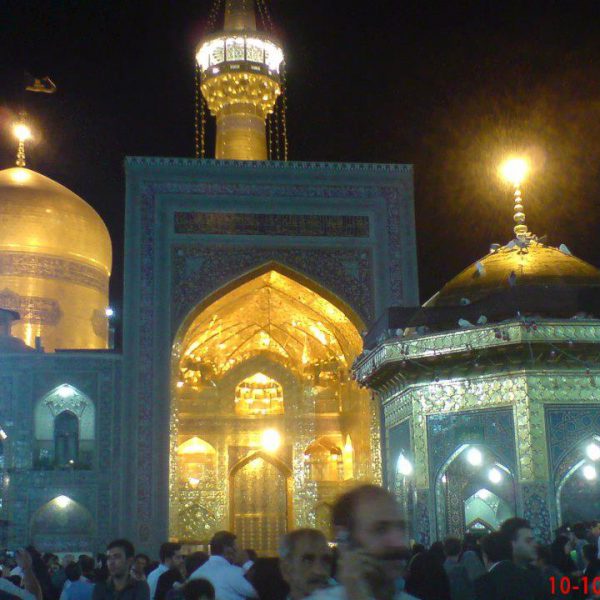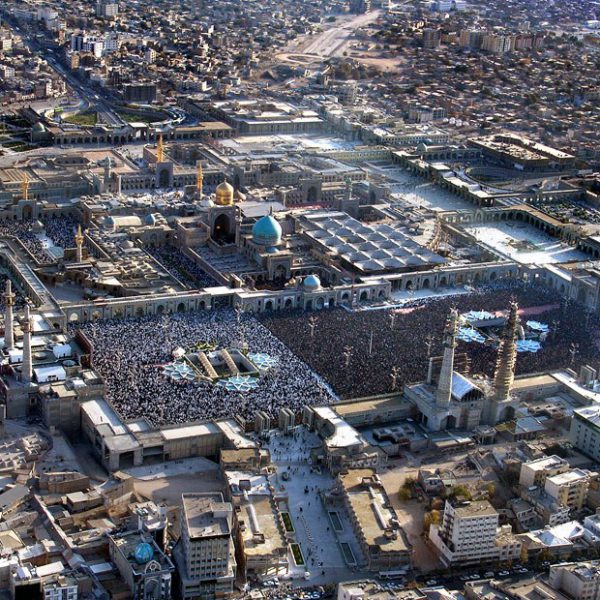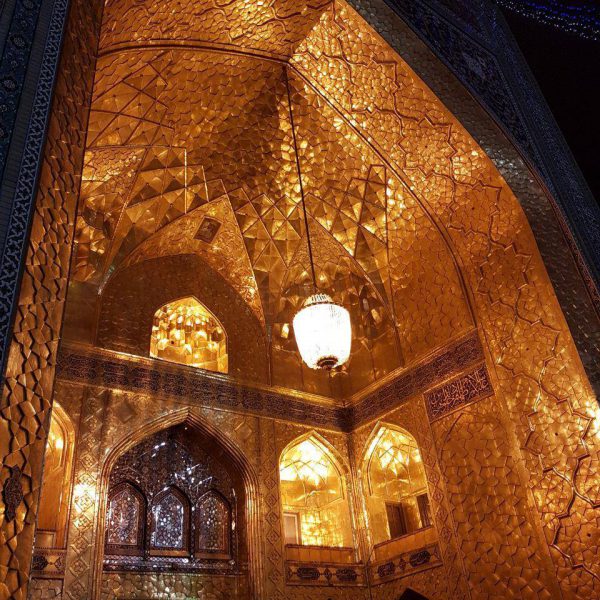MASHAD TRAVEL GUIDE
Things to Do in Mashad – Activities & Attractions
—————————Ο————————
Mashhad is situated in the north east of Iran, on a natural corridor that runs along the borders with Afghanistan and Turkmenistan between two mountain belts, and has hosted both merchants and invaders for centuries. Although not an ancient city, Mashhad is Iran’s second largest, the capital of the important province of Khorassan, and a centre of industry, commerce and learning. The city also holds the most sacred religious shrine in all of Iran, the tomb of the martyr Ali ar-Riza, (Reza in Farsi), eighth in the line of Shia Imams, appointed by the Caliph al-Ma’mun (813–833 AD) and killed two years later while travelling through this region. His tomb soon became a place of pilgrimage, and the surrounding town of Mashhad increased in size and wealth as a result. In the 15th century, the formidable Gowhar Shad, wife of Tamerlane’s son and successor, erected the splendid mosque that bears her name on this site, and is regarded to be one of the pinnacles of Iranian architecture.
The 16th century AD saw further development of and investment in the city, as the Safavid dynasty rose to power and imposed Shia Islam on the entire empire. Shah Tahmasp (1514-1576), and later Shah Abbas the Great (1587–1629), lavished grand buildings upon the shrine and endowed it with the broad thoroughfare that still bisects the city and gives access to the shrine at its centre. The city’s accessibility from the mountain passes laid it open to raids by Arghani, Uzbeks and Turkish nomads, but it also provided a vital resting point and trade Centre for the many merchants who passed along the same routes, and who enriched Mashad with their goods and ideas.
Housing the holy shrine of the eighth religious leader of the shiaa muslims , Mashhad is the most important pilgrimage center in Iran. Centrally located, is the gold – plated dome under which lies the leader’s tomb – Chamber. The dome is surrounded by a number of inter – connecting courtyards giving the shrine a highly charming beauty specially during the night when they are illuminated. Flanked by the holy shrine, are the famous 15 – century Gohar Shad Mosque, the Holy Koran museum, and Raza museum. A short excursion to the small town of Toos will give the traveler a chance to visit the burial place of Ferdowsi, the great Iranian epic poet. The other important sites of Mashhad are:
Imam Reza’s Shrine Compound
This is the main religious and architectural highlight of Mashad to visit incorporating several outstanding structures including the fantastic 15th-century architecture of Goharshad Mosque. Imam Reza, the 8th Imam of Twelver Shiites is buried here.
Tomb of Nader Shah
This is a monument inside Naderi Garden Museum. Mr. Houshang Seyhoun, a contemporary Iranian artist, has designed and built an eye-catching sculpture of Nader there. It shows Nader on the horseback with three people following him. There are two museum halls: one showcases some relics from the Afsharid era and the other one displays some images and documents about Nader Shah and Cornel Mohammad Taqi Khan Pesian.
Tavakoli House
The building is located near the holy shrine of Imam Reza. There are beautiful tile and brickwork as the decoration of this building. At the entrance of this building, there are verses of the Koran.
Ardakani House
The building dates back to the late Qajar period. It is an inscribed national heritage of Iran.
Shah-e Lafata Museum
The tourists interested in Ferdowsi and the Shahnameh are the fans of this museum. The museum was formerly a Zurkhaneh and has interesting details.
Daruqeh House
The Russian architects built this house in the late Qajar period. Until the past three decades, this monument was a residential place. However, Iranians restored the house in 1987 and made it public.
Vatanchi House
The building dates back to the late Qajar period. It is an inscribed national heritage of Iran.
Tomb of Pir-e Palandooz
The building is located in the northeast part of the shrine of Imam Reza in Mashad. The overall shape of the building and the paintings inside it prove that the monument belongs to the Safavid era, constructed in 1578.
Qafuri House
The house belongs to the Qajar period. It is an inscribed national heritage of Iran.
Koozeh Kanani House
The construction of the house dates back to 1868, during the Qajar period. It covers an area of more than 1000 m2. Architects of this house used the brick as the decoration. The house is now a provincial cultural heritage as well as the Constitution Museum.
Khooni Garden
This garden covers an area of 5.6 hectares. The Russian tsarist army fired cannonballs into Goharshad Mosque from this garden. According to the available documents, architects built Khooni Garden in the early Qajar period as a symbol of Iranian gardens in the southern part of the city walls of Mashad. As there is a spring in this garden, it is also famous for the Spring Garden. There were three separate buildings in this garden, two of which are demolished.
Tomb of Mir Qiaseddin Malekshah
The construction of this building dates back to 1743. There is a valuable tile decoration inside the tomb.
Malek House
This monument belongs to the late Qajar era. The house was much wider in the past, but only the exterior has remained now.
Hamam-e Shah Museum
The bath belongs to the Qajar period. The monument was the bath for the king and his courtiers.
Historical Attractions outside of Mashad
Mausoleum of Ferdowsy
This is resting place of the most famous Iranian poet in Tus who saved the Persian language by composing his book “Shahnameh” in 30 years when it was forbidden to write anything in Persian.
Haruniyeh
It is the mausoleum the famous Iranian Sufi, Imam Mohammad Ghazali in Tus, which is close to the mausoleum of Ferdosy. The brick structure is huge, worth visiting and representing 14th-century architecture.
Khorshid Palace
It is also known as Kakh-e-Khorshid located at Kalat e Naderi close to Turkmenistan border. The unique architecture of this structure in Iran is worth visiting and even the road to this monument is particularly attractive.
Robat Sharaf
This is one of the oldest caravansaries in Iran built in the 12th century with four-eyvan courtyard and beautiful brick decorations near Afghanistan border. It looks isolated and hidden although it used to be a major one on trade routes.
Mausoleum of Ahmad-e Jami
This is the burial place of a famous 12th century Iranian Sufi and poet in Torbat-e-Jam. Eight different structures have been built at this mausoleum since the 13th century.
Omar Khayam Mausoleum
The tomb of famous Iranian mathematician and poet of the 11th century was built in the 20th century in Neyshaboor. Architecture is geometrically sophisticated and fascinating in a beautiful garden.
Tomb of Farid-ud-Din Attar
This is the burial place of Iranian Sufi, poet, and theoretician of mysticism in the 12th century. The structure is 15th century built under Timurids in Neyshaboor.
Imamzadeh Mahruq
This is the mausoleum of the 10th-century religious figure built in the 16th century located in Neyshaboor.
Tomb of Khajeh Rabie
Around 6km north of Mashad, this tomb is the burial place of Imam Reza’s disciple decorated with beautiful calligraphy of Reza Abbasy.
Tomb of Khajeh Morad
It is just outside Mashad on Neyshabur road and is the burial place of one of Imam Reza’s disciple.
Tomb of Khajeh Abasalt
This is also another burial place of a disciple of Imam Reza just outside Mashad on Neyshabur road.
Natural Attractions of Mashad
Moghan Cave of Mashad
This cave is located 35 km of Mashad and south of Moghan Village. The cave has two openings and there are traces of stalagmite and stalactite. The cave has several wells.
Haft Howz Valley
This valley is located 16 kilometers from Mashad on Khalaj Road. It has a beautiful and intact nature. Haft Howz Valley is a summer quarter.
Koohsangi Region (Koohsangi Park)
This area is 8 km from the city center. Koohsangi Region is a mountainous area with rocky mountains where climbing is very easy.
Mashad Botanical Garden
This park is located outside the city of Mashad. However, accessing the subway is possible. Rose, medicinal herbs and fruit gardens are a part of the park attraction.
Vakilabad Garden
It is a jungle garden with a local zoo for recreation.
Qara Su Kalat Waterfall
This waterfall is located about 159 km from Mashad. It is located in the southwest of Kalat Naderi Village.
Darreh Al Cave
This cave is located in a village of the same name. Al village is intact and is a natural attraction with beautiful trees and streams.
Abardeh Village
The village is famous among tourists for its stir-like architecture.
Kang Village
The village is located 40 km from Mashhad. It’s an stepped village with very vernacular architecture. The special architecture of houses that the roof of one home is the yard of the other .



